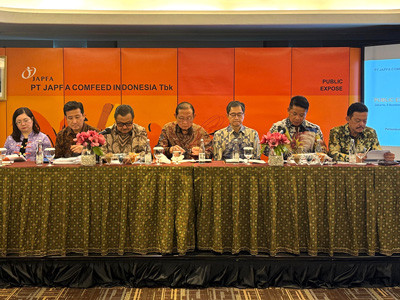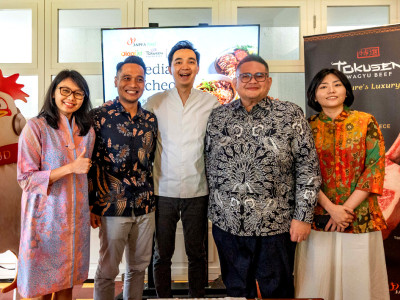Santori Drives Welfare Culture
Fourteen months ago, the head of Indonesia’s largest cattle importing business knew a tough road lay ahead if his company was to keep its trade with Australia open.
Like all other Indonesian lotfeeders who wanted to continue buying Australian cattle, PT Santosa Agrindo (Santori) had little choice but to make major investments in infrastructure upgrades and staff training to satisfy new Australian Government rules on cattle imports.
“It was like going to the Olympics,” Mr Wibisono told a small gathering in Jakarta last Thursday night.
“But in some ways it was more difficult than the Olympics because the goal kept moving.”
The goal he was referring to was ESCAS, the Exporter Supply Chain Assurance System introduced by the Australian Government in Indonesia last July to assure the welfare of all exported animals in foreign supply chains.
Santori was already well advanced in welfare standards with its own ISO9002 accredited feedlots and modern abattoir, but still faced significant investments to improve training, traceability and equipment in the various abattoirs it supplies throughout Indonesia, and to train and activate new teams of animal welfare officers.
So far that process has cost the company US$800,000, and the bill will continue to rise by $40,000 every time it completes one of several independent third-party audits that are required each year.
Such is now the cost of doing business with Australia, a considerable investment in time and money that buys little more than the right to continue buying Australian cattle.
Despite the onerous nature of the new requirements, Santori has not only accepted the new system but has embraced it, and is actively working to embed a culture of animal welfare throughout its entire supply chains.
Last week in Jakarta, Santori held a function to celebrate the milestone of achieving 50,000 cattle imports since ESCAS was implemented.
To mark the occasion it invited the producer that bred the 50,000th animal – AA Co - the exporter that shipped it – Wellard Rural Exports – and the abattoir owner and wet market butcher that processed it to tour its feedlots in Sumatra, followed by a celebration involving dozens of the company's frontline animal welfare officers and supply chain employees.
Unsung heroes
In many ways the teams of Australian-trained Indonesian animal welfare officers (AWOs) who now man every ESCAS approved abattoir in Indonesia are the unsung heroes of the industry.
From 11pm into the wee hours of each morning, day in, day out, they watch over abattoirs to ensure imported cattle are being processed to Australian Government-approved standards in Indonesia.
Without their dedicated efforts, Australia’s trade with the market simply could not continue.
In recognition of the important role they play, Santori invited all of its AWOs from the greater Jakarta area to join in the 50,000 head milestone festivities last Thursday.
The event was also held to honour the winner of Santori’s inaugural Animal Welfare Officer of the Year award with a special presentation.
When the formal part of the evening was over, the AWOs all said their cheery goodbyes and then disappeared into the steamy Jakarta night to return to their jobs overseeing processing operations in the ESCAS-approved abattoirs around the city.
Light at the end of the tunnel
Wellard South East Asia General Manager Scot Braithwaite paid tribute to Santori’s leadership in implementing ESCAS during what could only be called ‘dire circumstances’.
“We were delivered into the darkness, but now we can all see some light at the end of the tunnel,” Mr Braithwaite told the gathering.
“We now have a client who has handled 50,000 cattle without a blemish on its record, and it has a traceability system that is absolutely second to none.
“We know where all cattle are at any time, the system works, and the effort and time Santori has invested is paying dividends.”
AA Co chief operating officer Troy Setter commended Santori on its achievements in such a short amount of time, and noted that the experience of the past 12 months had served to bring all parts of the live export supply chain closer together.
“It has strengthened relationships, and I think the producers, exporters and importers are coming together and really working at how we can make the industry stronger and more viable for the future,” Mr Setter said.
Jakarta-based Australian Government representative Bruce Wallner told the audience that in many ways it was fortunate that ESCAS had first been introduced in Indonesia, because of the preparedness of companies such as Santori to make the changes happen, rather that arguing over the detail.
He said Santori’s leadership had been important in getting the “buy-in” from the broader industry.
“The spirit of cooperation and the ability of people to be tolerant about the frequent changes as we evolved and worked out what we are doing in the very early stages I think was a testament to the patience and the willingness of Indonesia to cooperate,” Mr Wallner said.
“What has happened is that we have got a system up and running in a remarkably short period of time.”
'Have faith'
Santori head of Government Relations and Business Development Dayan Antoni told Beef Central that despite the current challenges, Santori sees a strong future for the trade, demonstrated by its significant investment in ESCAS.
His message to northern Australian cattle producers who rely on the trade was simply this: “Have faith”.
Samuel Wibisono said that that after 50,000 head of cattle had been processed, the ESCAS process “looked easy now”.
But, just like the Olympics, those watching from outside did not see hard work that had gone on behind the scenes.
“For the audience who watches the Olympics, it looks easy,” he said.
“But they don’t know the hardship, they don’t know the hard work, the training, the discipline that went to preparing for that Olympic event.
“The consequence of tonight’s celebration, is that the world is going to be watching.”
Mr Wibisono said the challenge now was, with the world indeed watching, to maintain high welfare standards.
“The message is that from what it was 14 months ago, what used to be dark, backyard slaughter houses, now we can present a bright, systematic, transparent system that we have developed together.”
Related article: The ins and outs of ESCAS
for more detail visit : http://www.beefcentral.com/p/news/article/2150


